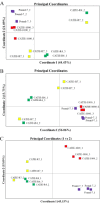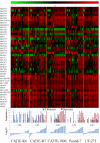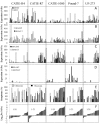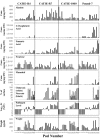Differential gene expression by Moniliophthora roreri while overcoming cacao tolerance in the field
- PMID: 24612180
- PMCID: PMC6638715
- DOI: 10.1111/mpp.12134
Differential gene expression by Moniliophthora roreri while overcoming cacao tolerance in the field
Abstract
Frosty pod rot (FPR) of Theobroma cacao (cacao) is caused by the hemibiotrophic fungus Moniliophthora roreri. Cacao clones tolerant to FPR are being planted throughout Central America. To determine whether M. roreri shows a differential molecular response during successful infections of tolerant clones, we collected field-infected pods at all stages of symptomatology for two highly susceptible clones (Pound-7 and CATIE-1000) and three tolerant clones (UF-273, CATIE-R7 and CATIE-R4). Metabolite analysis was carried out on clones Pound-7, CATIE-1000, CATIE-R7 and CATIE-R4. As FPR progressed, the concentrations of sugars in pods dropped, whereas the levels of trehalose and mannitol increased. Associations between symptoms and fungal loads and some organic and amino acid concentrations varied depending on the clone. RNA-Seq analysis identified 873 M. roreri genes that were differentially expressed between clones, with the primary difference being whether the clone was susceptible or tolerant. Genes encoding transcription factors, heat shock proteins, transporters, enzymes modifying membranes or cell walls and metabolic enzymes, such as malate synthase and alternative oxidase, were differentially expressed. The differential expression between clones of 43 M. roreri genes was validated by real-time quantitative reverse transcription polymerase chain reaction. The expression profiles of some genes were similar in susceptible and tolerant clones (other than CATIE-R4) and varied with the biotrophic/necrotropic shift. Moniliophthora roreri genes associated with stress metabolism and responses to heat shock and anoxia were induced early in tolerant clones, their expression profiles resembling that of the necrotrophic phase. Moniliophthora roreri stress response genes, induced during the infection of tolerant clones, may benefit the fungus in overcoming cacao defense mechanisms.
Keywords: Moniliophthora roreri; RNA-Seq; Theobroma cacao; disease tolerance; frosty pod rot; hemibiotroph; metabolite.
© 2014 BSPP AND JOHN WILEY & SONS LTD.
Figures






References
-
- Adomako, D. (1972) Cocoa pod husk pectin. Phytochemistry, 11, 1145–1148.
-
- Ali, S.S. , Melnick, R.L. , Crozier, J. , Philips‐Mora, W. , Strem, M.D. , Shao, J. , Zhang, D. , Sicher, R. , Meinhardt, L. and Bailey, B.A. (2014) Successful pod infections by Moniliophthora roreri result in differential Theobroma cacao gene expression depending on the clone's level of tolerance. Mol. Plant Pathol. Accepted article, DOI: 10.1111/mpp.12126. - DOI - PMC - PubMed
-
- Argout, X. , Salse, J. , Aury, J. , Guiltinan, M. , Droc, G. , Gouzy, J. , Allegre, M. , Chaparro, C. , Legavre, T. and Maximova, S. (2010) The genome of Theobroma cacao . Nat. Genet. 43, 101–108. - PubMed
-
- Bailey, B.A. , Bae, H. , Strem, M.D. , Antúnez de Mayolo, G. , Guiltinan, M.J. , Verica, J.A. , Maximova, S.N. and Bowers, J.H. (2005) Developmental expression of stress response genes in Theobroma cacao leaves and their repsonse to Nep1 treatment and a compatible infection by Phytophthora megakarya . Plant Physiolol. Biochem. 43, 611–622. - PubMed
Publication types
MeSH terms
LinkOut - more resources
Full Text Sources
Other Literature Sources
Research Materials

